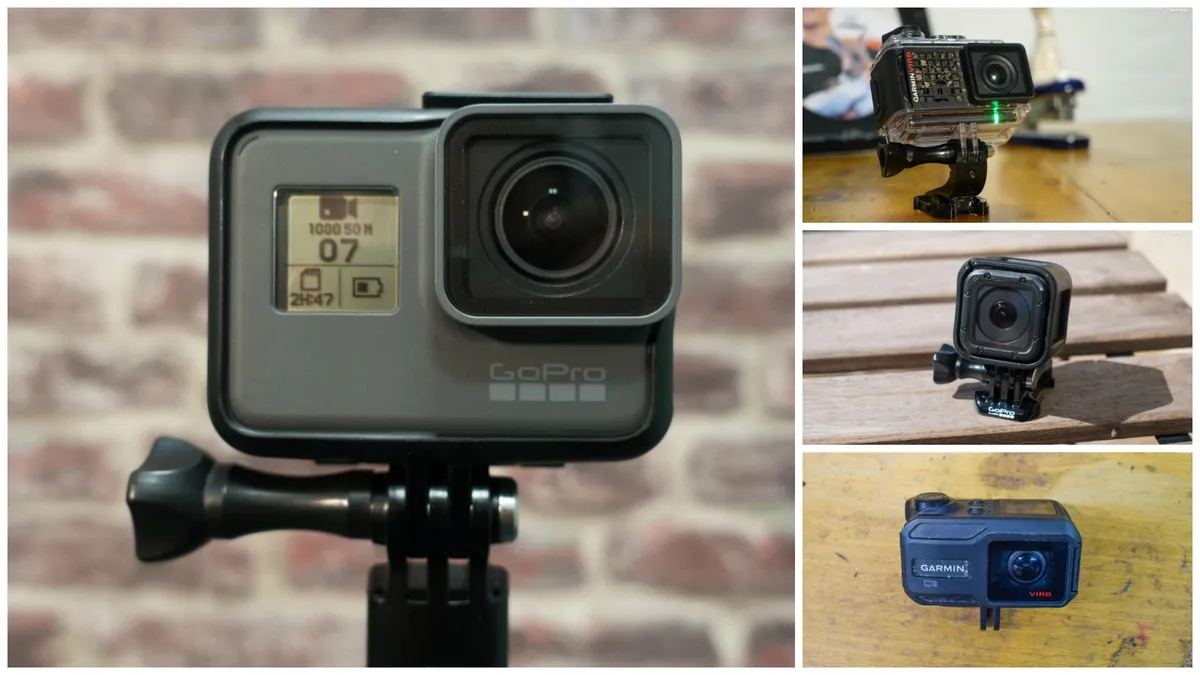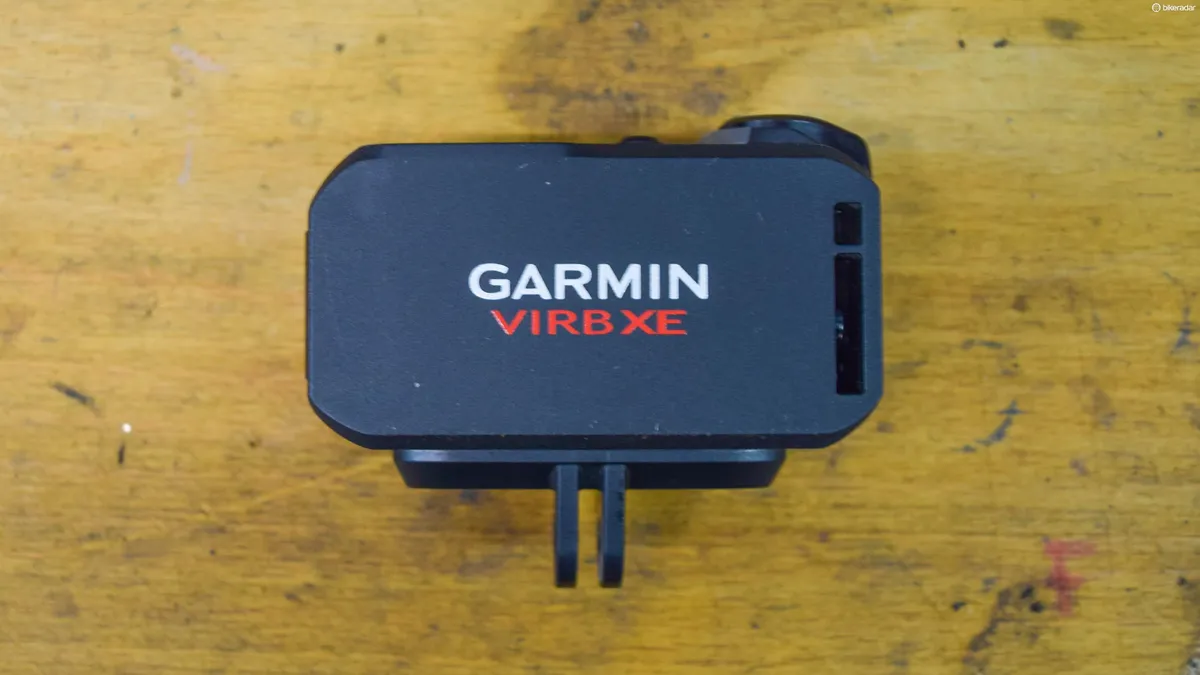OK, so you want to buy an action camera to film your riding adventures. The good news is that picture quality and battery life are improving all the time. Thanks to their ubiquity, a GoPro is the obvious choice but is it the best camera? Are there any decent alternatives? And which is the best GoPro model? We’ll run you through the different options that we’ve used extensively to help you choose the best action camera for your needs.
- GoPro Hero 5 Black review
- GoPro Hero 5 Session review
- GoPro Karma drone official price, specs and features
For this guide, we’ve recruited the experts — our BikeRadar video team. Not only are they professional videographers who use these devices on a daily basis, but they also ride their bikes very, very fast. They took time out of their busy filming schedule to tell us what they like and dislike about these cameras, how suitable they are for cyclists and what sort of value they represent. All opinions are based on using each camera extensively.
We'll also be keeping you up to date with news about the GoPro Hero 6, which was recently announced. Pop on over to our GoPro Hero 6 article for the latest dates, prices, specs and rumours as we get them.
(This article was updated 8 February 2017)
What to look for in an action camera
Picture quality
Of course, any camera worth its salt has to deliver a good quality picture. While camera makers like to dazzle consumers with resolution numbers and frame rates, a lot of that boils down to marketing speak. For example, 4K resolution is only great if the frame rate is reasonable. 15 frames per second delivers footage that isn’t usable; in our opinion, it looks like security camera video.
It’s also worth bearing in mind that picture quality can be hugely affected by the lens and the processor in the camera, that’s why GoPro footage consistently looks good and why the videos created by cheap imitations often look a bit rubbish.
Battery life
This is definitely a key consideration, but perhaps the first question is: how long do you actually need to film for? Because, if it’s just your commute then you probably don’t need a three-hour battery life. Our video team commonly find themselves hitting the record button for certain segments of a ride, rather than recording the entire thing. It saves on editing time and eliminates the danger of recording over old footage if you’re using the looping feature. What is video looping? It simply means recording over old footage after a specified duration to prevent running out of memory space.
Usability
No matter how good the picture quality is or how long the battery lasts, if you hate using your action camera due to flaws in the hardware or software, you won’t film anything. Much like a bike, in fact. Of course, no action camera is perfect, but — as with bikes — some are better than others and some have shortcomings that you can live with.
So it's also worth considering the ergonomics — how it feels to handle, press the buttons and swap the batteries — as well as the navigation of the on-device menus and if the software is designed for any companion app or editing software, and how well it attaches to your mount of choice. As we'll see below, many manufacturers are adopting the GoPro mount as standard, but some do it better than others.
Value for money
Possibly the biggest question of all. We all know you’ll pay a premium for the big brand names, but does that translate into superior quality? And do you really need all the latest features, highest frame rate and longest battery life, or is something simple like the GoPro Hero 4 Session a better bet for your needs?
The best action cameras
GoPro Hero 5 Black
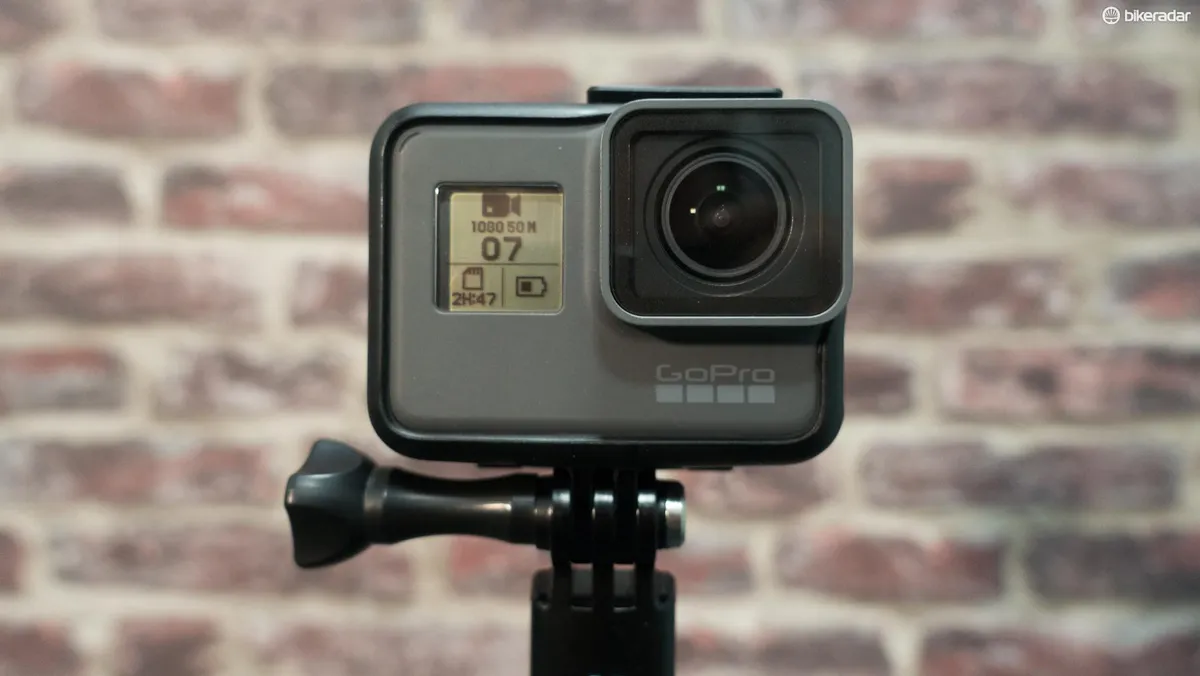
- Price: £349 / $399 / AU$ 549
- Buy from GoPro
- Best-in-class 4K image quality, waterproofing to 10m, improved menus
- Clever features like voice control and image stabilisation
- Battery still doesn’t last more than two hours and it’s not cheap
We’ve finally got our hands on GoPro’s Hero 5 Black for review. Aside from the obvious redesign, there are a number of new features including voice commands, electronic image stabilisation, a redesigned menu system and updated frame rates. The Hero 5 is definitely one of the hottest tech gadgets to come out this year and we think this is now the best GoPro on the market.
The size and layout of the camera feels very familiar for those who’ve previously used a GoPro and the ergonomics retain the style we’re used to, but there is a clear difference in appearance between this one and the previous models. One of the main things about this redesign is that the actual unit is now fully waterproof down to 10 metres without the need for a separate housing. To protect it further, GoPro has released the Super Suit housing which is rated down to a depth of 60 metres and affords better crash protection.
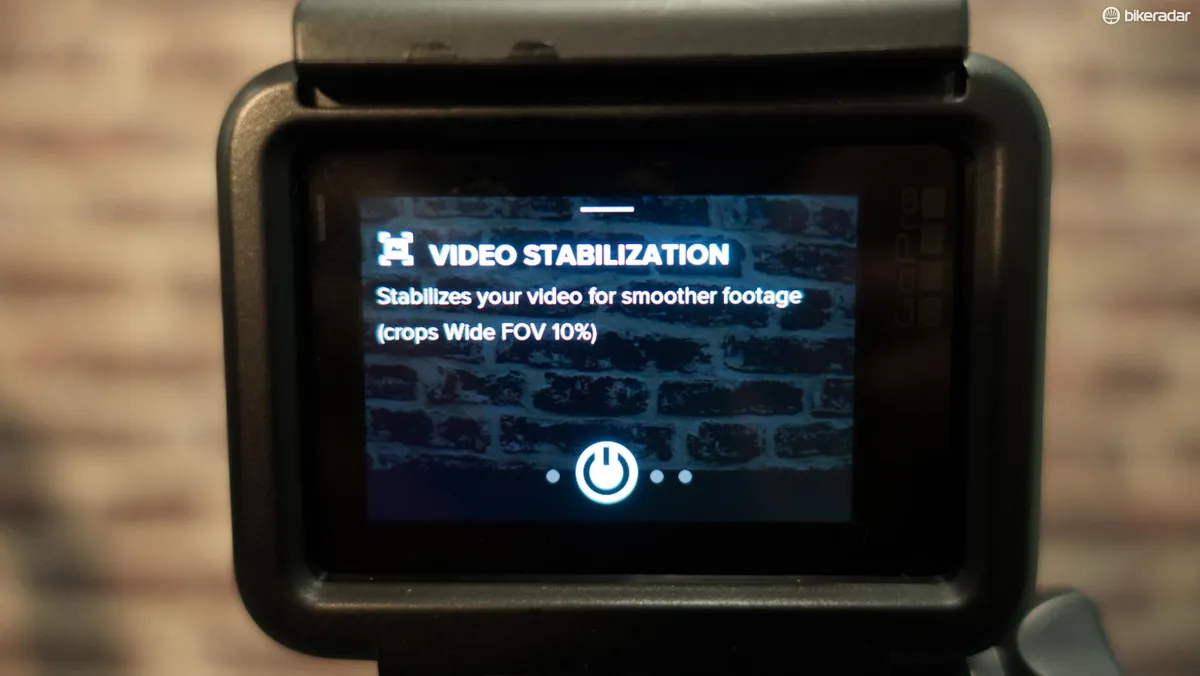
The Hero 5 Black sports a totally redesigned menu and it’s a dead smart design at that. Swipe from the left and you get SD card playback, swipe from the right to get settings for image stabilisation, low light and the Protune feature, which helps you enhance your footage. Swiping from the top gives you access to general camera system settings like WiFi and voice control. It’s all pretty intuitive meaning you can’t ever really get lost and if somehow you do, you just swipe from the top to get back to the camera preview.
4K resolution is still limited to 24fps and 25fps, but it’s a very clear, sharp image and is considerably better than the 4K in the Hero 4 Black, which is as you’d expect. Electronic image stabilisation is now a core part of the Hero 5 family of cameras and it’s been done incredibly well. You get a bit of a floaty feeling with the footage but nothing that ever dips into motion sickness territory.
- Read our full GoPro Hero 5 Black review
Garmin ViRB Ultra 30

- Price: £369 / $399 / AU$699
- Buy now from Garmin
- Superb video quality, way better 4K than the GoPro Hero 4 Black
- Simple, clear, clean user interface
- Useful, clever features like voice control and electronic image stabilisation
There's a new top-end action camera from Garmin that records 4K video at 30 frames per second. What's more, the Garmin ViRB Ultra 30 has a touchscreen, voice control ("Remember that!"), a faster GPS chip and live broadcasting. We’ve been using it extensively since its launch at Eurobike 2016 and the thing that’s impressed us the most is the quality of video it produces. Seriously, it’s superb.
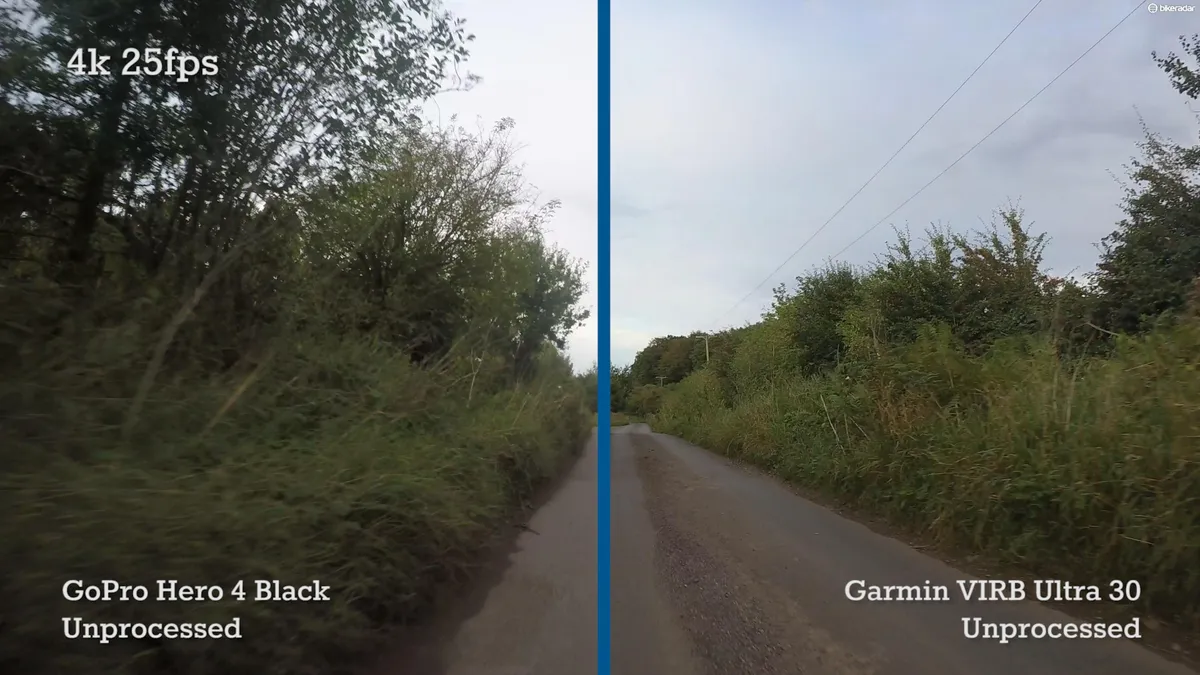
The quality of this action camera's footage is its standout feature: it records 4K resolution at 30 frames per second and we think the footage is considerably better, sharper and more detailed than the GoPro Hero 4 Black. In fact, we think it blows it out of the water — see the screenshot above that compares them side-by-side.
The user interface is one of the best we’ve seen too on an action camera, with simple, clear and colourful icons. Video playback on the 1.75” rear touchscreen is good and it’s also got a quick menu that’s accessible by swiping from left to right on the touchscreen — where you can change settings like frame rate, resolution, WiFi etc.
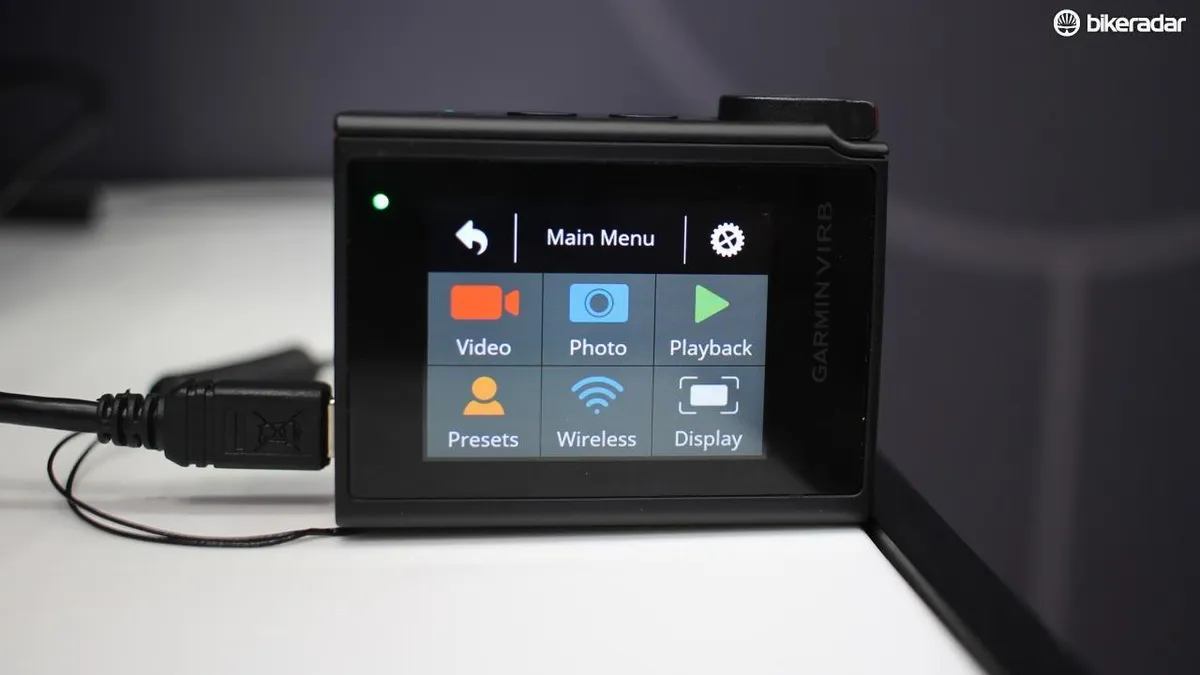
It's got four quick modes as well: video, slow-mo (up to quarter speed at 120fps 1080p = 30fps slow-mo), time-lapse and expansive, which changes the aspect ratio to make it a bit more square.
The Garmin ViRB Ultra 30 also has voice control, which actually works pretty well. The digital image stabilisation feature works well once you’ve updated the camera’s software to 2.70 and the footage is noticeably smoother when activated even when hammering the bike out of the saddle or over rough terrain.
The Garmin ViRB Ultra 30 has lots of wireless connectivity for sensors like heart rate and GPS, and you can control it on your Fenix 3 watch or Garmin Edge computer if you like. You can also stream live footage to a YouTube channel via the Garmin app on your smartphone.
In terms of battery life though, it’s quite a bit lower than claimed. We measured the Garmin ViRB Ultra 30’s battery life with the camera set at 1080p/30fps, and with GPS on, and it lasted 1:31hrs. You could certainly get more battery life with the GPS switched off. Garmin claims that battery life when recording at 1080p/30fps is 2h15mins of battery life — a big difference from our experience.
- Read our full Garmin ViRB Ultra 30 review
Garmin ViRB XE
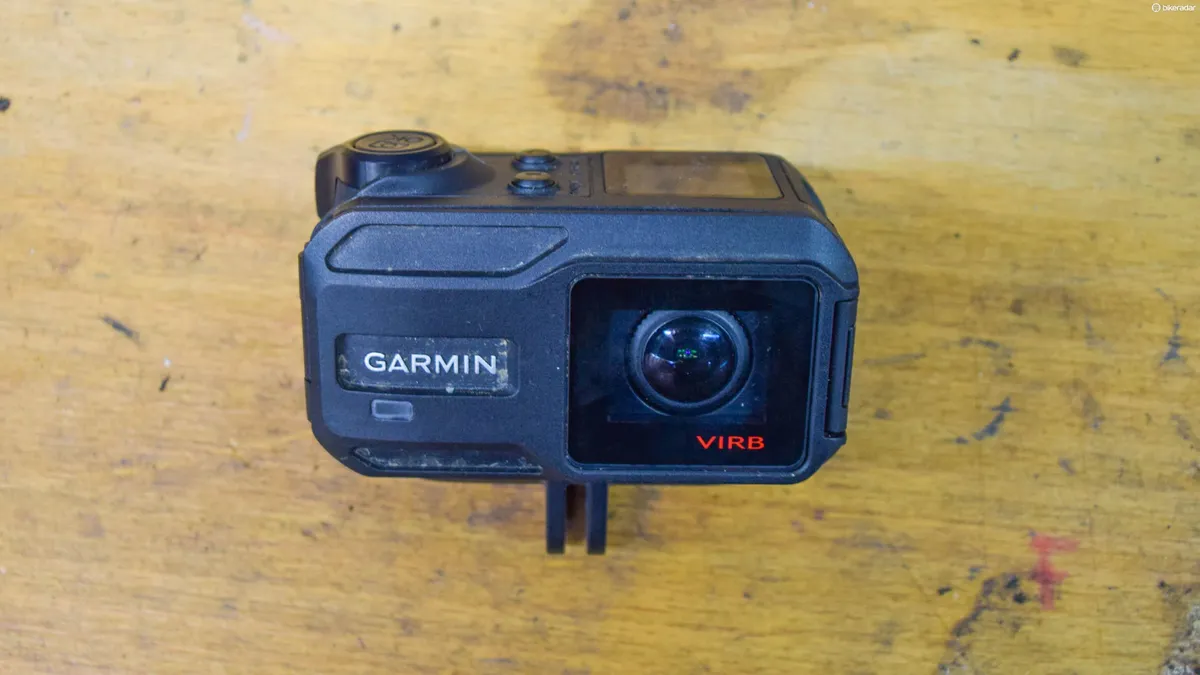
- Price: £349 / $399 / AU$ 589
- Buy now from Garmin
- Solid, tough design that can take plenty of knocks
- Good quality video footage, but no 4K
- Some nice features like remote control and metrics overlay
This is a super-rugged action camera. If you dropped it, you’d be more worried about the floor than the camera. It feels well-put-together, has buttons with a positive-feeling click and a solid connector for charging the battery (shame this is proprietary though, as is the tendency with much of Garmin’s hardware). We love the physical on/off switch, which rotates to power it on — leaving you no room for error.
The footage it takes is good too. It’ll film in 1440p at 30 frames per second, 1080p at 60fps and 720p at 120fps. There’s a slow-mo mode too, which shoots 420p resolution at 240fps. The image quality is perhaps a touch soft compared to the GoPro Hero 4 Black, but for your average consumer that won’t be a problem.

The battery has a decent runtime, close to the two hours claimed when filming at 1080p. You can swap out the battery too, though it’s a bit fiddly. The menu’s really nice, it’s super easy to use with a great screen on top of the unit for cycling through menus. It’ll overlay metrics like speed and distance onto footage (thanks to the inbuilt GPS) via the free ViRB Edit software.
It’s quite pricey, comparable with the GoPro Hero 4 Black, and we’re not sure a consumer needs to spend that much money on an action camera. Little extras like being able to control it via your Garmin Edge bike computer and overlay metrics onto footage are nice, but not worth spending that much more on.

In terms of suitability for cyclists, it’s definitely able to cope with some rough and tumble. It’s waterproof up to 50 metres, which is more than most cyclists need, but it’s quite heavy, so it’s more suited to mounting on the bars or under the saddle. You won’t want it on your chest.
GoPro Session
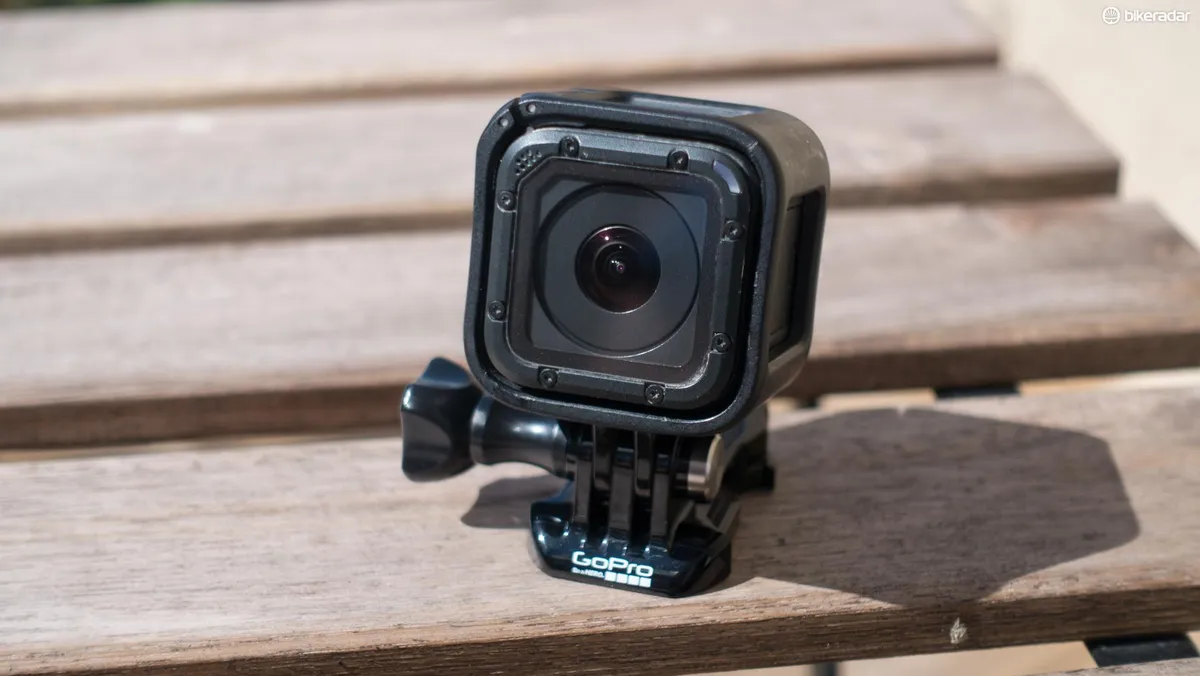
- Price: £179 / $199 / AU$ 299
- Buy now from GoPro
First, let's clarify something — this is the 'older' GoPro Session, previously called the Hero 4 Session, which launched in mid-2015. It's easily confused with the GoPro Hero 5 Session, which looks near identical but packs 4K filming, image stabilisation and voice control, and was launched in September 2016.
Let’s start with the most obvious thing about the GoPro Session action camera: it’s tiny. It looks great on the bike, tucked under your saddle or handlebars, you’ll barely notice it’s there. It’s bang on for cyclists, whether you’re road riding, mountain biking, commuting or racing. Or stick it in your jersey pocket and film your mates as you’re riding along. Oh, it’s waterproof to 10m too, no case needed.
The picture quality of the Hero 4 Session is good, but noticeably below the GoPro Hero 5 Black with its higher resolution, frame rate and processing power. You’ll get 60 frames per second at 1080p or 720p at 100 frames per second. They’re increasingly being used for race footage, with partnerships like Velon showing what the Session is capable of. Value for money is pretty good too.

On the negative side, you can’t change the battery, which lasts around two hours, so you’ll need to carry a portable back-up if you’re doing a long ride. The menu’s a bit confusing at times too, due in part to the tiny screen, so we’d recommend the GoPro app to change settings — the user interface on the Hero 5 Black is considerably better. Also, it occasionally does weird things, such as when you enable WiFi it sometimes just switches itself off.
Also tested
GoPro Hero 5 Session
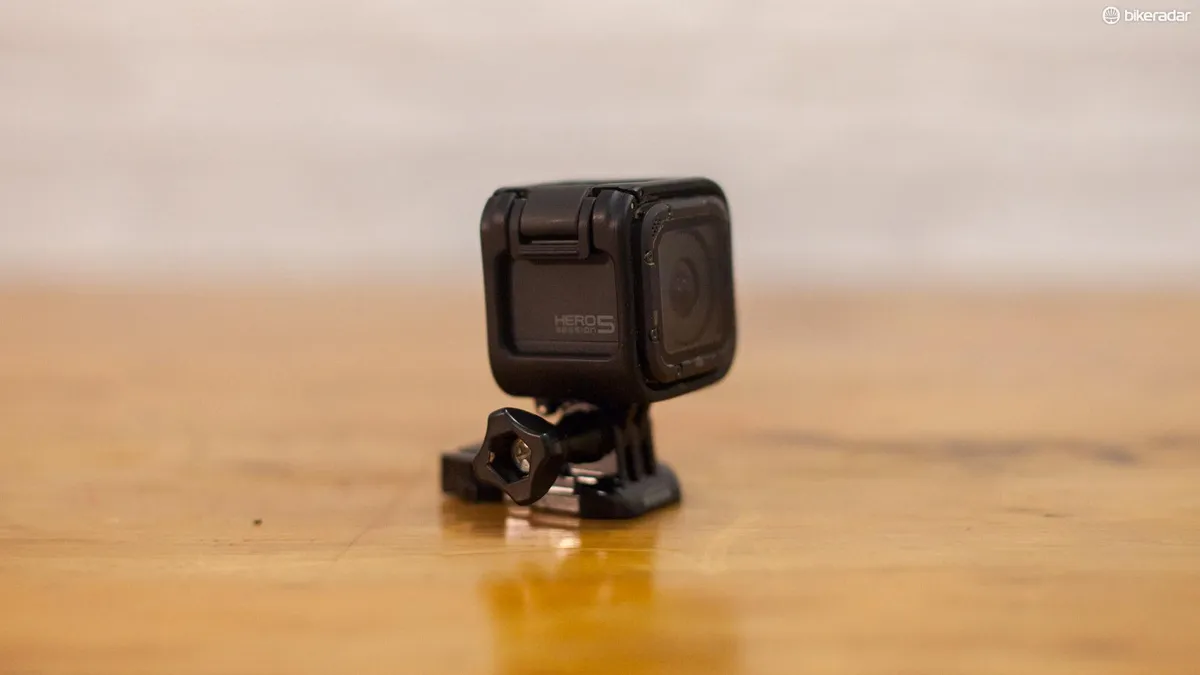
- Price: £249 / $299 /AU$469
- Buy now from GoPro
- Very good image quality, low weight, tiny size, simple usability
- Fit-and-forget performance, useful voice activation features
- Poor cold-weather performance and unrefined image stabilisation
The GoPro Hero 5 Session may look the same as its predecessor, but it now boasts 4k image quality, voice control, video stabilisation and a USB-C connection, as well as updated and increased frame rates and resolutions. Ultimately, this is a tiny little camera that weighs just 72g — for reference, the Hero 5 Black weighs 119g without the protective frame.
If you’re using remotes or the voice activation feature, which work well enough, this is almost a fit-and-forget camera. It lends itself perfectly to being used for short races — think cyclocross or cross-country. Users now have the option of recording 4k footage at 30fps, as well as 1440p at 60fps or 1080p at 90fps. The latter’s not quite the 120fps of the Hero 5 Black, but it’s a nice option.
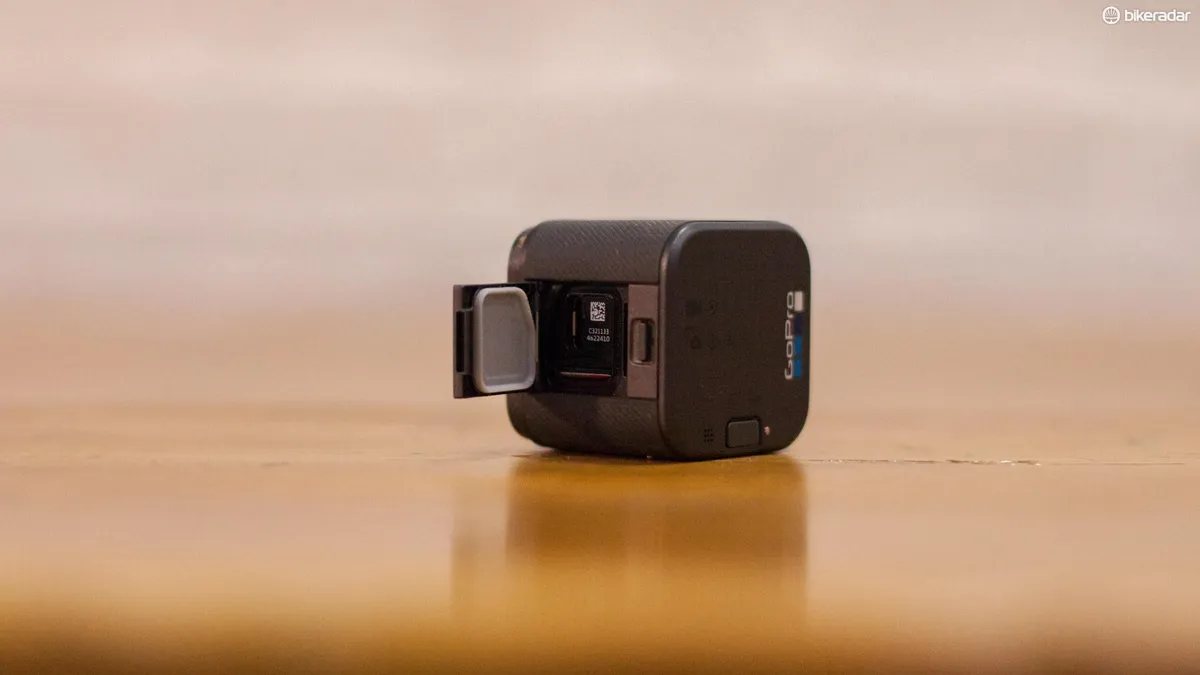
The picture quality is crisp and easy to look at. However, the image stabilisation isn’t quite as refined as the Hero 5 Black. While it’s not bad, it can be quite noticeably ‘wavy’ in places and for many people there’s an off-putting floating feeling.
We also had some issues with cold temperatures affecting operation: when we left the camera in the (warm) office for a full-to-empty run-down test, we had a total of 1 hour, 50 minutes and 15 seconds of recorded video. However, during a cold group ride in the mid-single-digit celsius temperatures this nearly halved, and on an even colder ride in 0 to -5 Celsius, the camera shut down entirely, we assume to protect itself.
- Read our full Garmin Hero 5 Session review
Discontinued GoPro models
So that's the best GoPro action cameras on the market at the moment, but what about their predecessors? Well we've used models like the Hero 4 Black and Hero 4 Silver extensively and they can still be found on eBay for a bargain price. Let's have a look…
GoPro Hero 4 Silver

- Good range of footage quality, including 4K at 15fps and 720p at 120fps
- Ability to shoot 30 12MP still images per second
- Waterproof to 40m
The GoPro Hero 4 Silver is very user friendly and delivers great image quality. It launched back in autumn 2014, has a 1.75in rear touchscreen display for camera set up and playback, and a small front screen showing status. It can record video at five qualities, from 4K at 15 frames per second (as mentioned above, not really useful), to 720 pixels at 120fps. With the new Hero 5 Black now out, this model is no longer being sold by GoPro, but you may be able to pick up a bargain as retailers clear their stock.
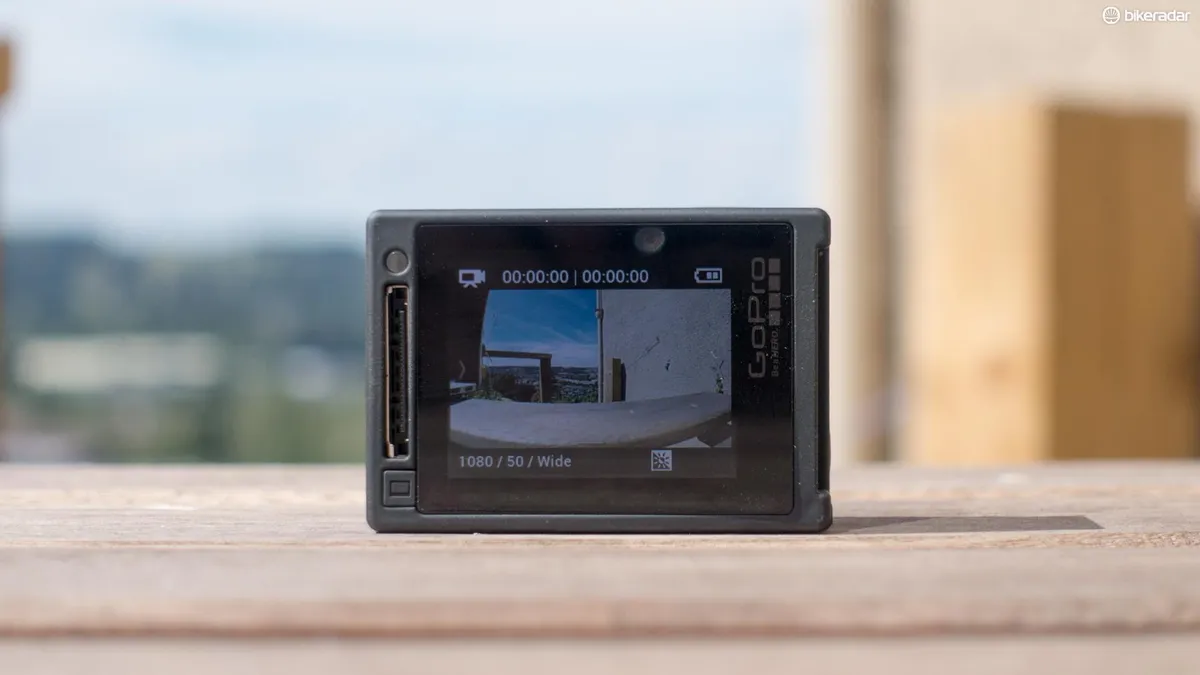
The Hero4 will also shoot 30 12MP still images every second for timelapse shots and there’s even built-in WiFi and Bluetooth for remote control or viewing via the mobile app. Once safely secured in its waterproof housing, the camera weighs just 147g and is waterproof to a depth of 40m. The boxy shape isn’t very sleek. A QuikCapture function powers up the camera and starts recording with one button press — child’s play. Battery life depends on shooting mode and can be anything from under an hour to around two.
The f2.8 fixed-focus lens’s ultra-wide view equates to around 17mm, fisheye focal length, with impressive sharpness from your brake levers to infinity. Video is remarkably flare-free, colours are accurate, if a little muted, and the camera manages changeable scenes superbly, handling highlights and shadows surprisingly well, while maintaining good contrast. There’s very little pixelation too, so paused video can still look image-sharp.
- Read our full GoPro Hero 4 Silver review
GoPro Hero 4 Black
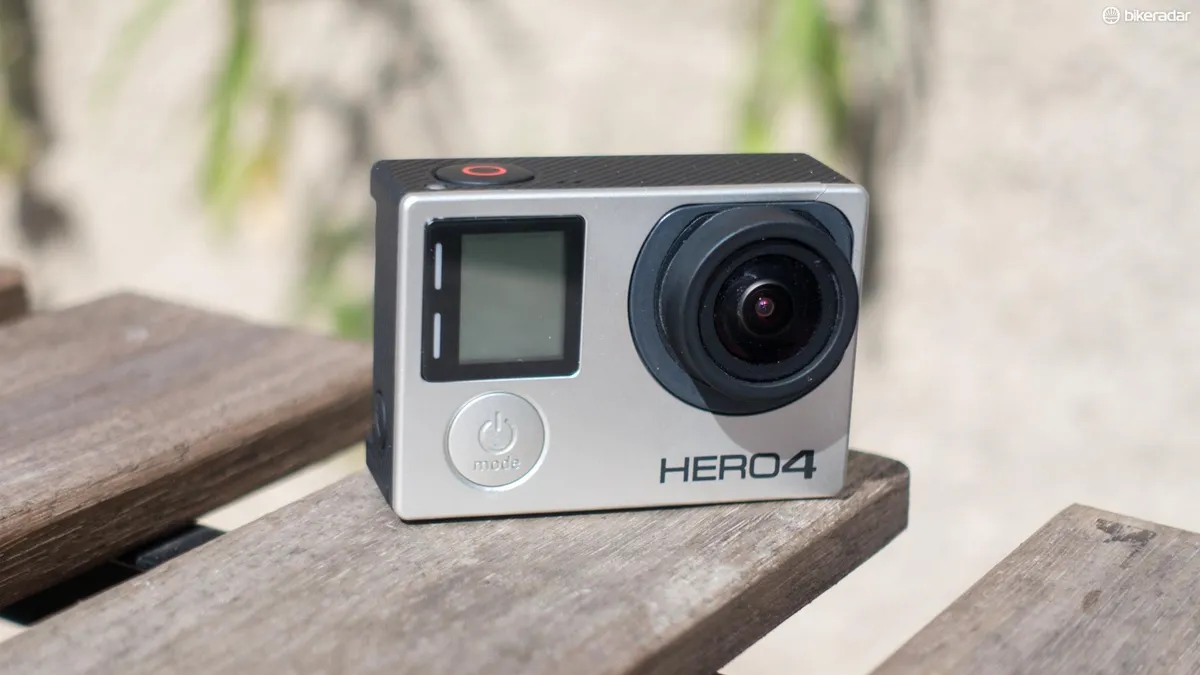
- Solid 4K footage at 30fps
- No touchscreen on the rear for framing your shot
- Slightly bulky design
Until recently, the Hero 4 Black was GoPro's top-end action camera. It has higher frame rates than the Silver, making 4K filming actually usable at 30fps. Another big difference is that the Black doesn’t have a touchscreen on the rear for framing your shot, so unless you’ve got the companion app running on your phone, you’re firing blind. You can buy a clip-on screen called the Go BacPac for around £70 / $80 / AU$120, but that takes up extra space on the back.
It’s got a pretty decent replaceable battery that lasts around 3hrs. The design is a bit bulky, very similar to the Hero 4 Silver, and again needs to be protected by a case to waterproof it. The buttons have a pretty good positive click, which feel slightly better on the Black than on the Silver, though that could be because of the case buttons. When it’s in the case, you do find yourself checking whether the device is recording or not.

The user interface on the camera is pretty easy. There are just three buttons, so you won’t get lost: one button to flick through menus, a side button to go into more depth in that menu, and the top record menu to confirm your choices. You can change all settings using the camera or the app. Its only screen is around 1cm square, but the folks at GoPro have done a really good job of getting all the information you need into that little screen.
It’s not particularly good value for money at £409, though with the Hero 5 Black now out, you'll probably find it on sale for much less as retailers clear their stock. This is for 'prosumer'-level filming: if you’re serious about your video, you’ll go for the Black. In terms of suitability for cyclists, it’s fine to stick on your bars or under your Garmin mount, but it’s not the sort of camera you’d want to wear on a chest mount very often, due to its size and weight. Under your handlebars or saddle though, you won’t really notice it.
